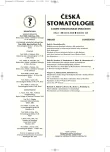Blockade of Nervus Alveolaris Inferior in 284 Patients with Semi-retained and Retained Lower Wisdom Teeth: Our Experience
Authors:
J. Šedý; B. Navrátilová
Authors‘ workplace:
Stomatologická a Stomatochirurgická ambulance, Praha
vedoucí MUDr. B. Navrátilová
Published in:
Česká stomatologie / Praktické zubní lékařství, ročník 108, 2008, 1, s. 4-8
Overview
Summary:
Local (regional) anesthesia aimed at inferior alveolar nerve was administered in 284 patients by the direct Halsteadt method for the extraction of semi-retained and retained lower wisdom teeth. Artikain or meprivakain were used for this purpose. The average amount of the required anesthetic was 2.84ml. The study has shown that in vertical position of semi-retained teeth, one dose of the anesthetic is usually sufficient. In other cases it is necessary to expect administration of two doses, rarely even more than that.
Key words:
dens molaris tertius - anesthesia - nervus alveolaris inferior – semi-retained and retained lower teeth
Sources
1. Machálka, M.: Chirurgie dolních zubů moudrosti. Praha, Grada, 2003. 59 s. ISBN 80-247-0605-9.
2. Ščigel, V.: Lokální anestezie v praxi zubního lékaře. Praha, Quintessenz, 2004, 216 s. ISBN 80-903181-4-2.
3. Colombini, B. L., Modena, K. C. S., Calvo, A. M., Sakai, V. T., Giglio, F. P. M., Dionisio, T. J., Trindade, A. S., Lauris, J. R. P., Santos, C. F.: Articaine and mepivacaine efficacy in postoperative analgesia for lower third molar removal: a double-blind, randomized, crossover study. Oral Surg Oral Med Oral Pathol Oral Radiol Endod, roč. 102, 2006, č. 2, s. 169-174.
4. Checchi, L., Alessandri Bonetti, G., Pelliccioni, G. A.: Removing high-risk impacted mandibular third molars: a surgical-orthodontic approach. J. Am. Dent. Assoc., roč. 127, 1996, č. 8, s. 1214-1217.
5. Alessandri Bonetti, G., Pelliccioni, G. A., Checchi, L.: Management of bilaterally impacted mandibular second and third molars. J. Am. Dent. Assoc., roč. 130, 1999, č. 8, s. 1190-1194.
6. Kim, H. K., Lee, Y. S., Kho, H. S., Yum, K. W., Chung, S. C.: Facial and glossal distribution of anaesthesia after inferior alveolar nerve block. J. Oral. Rehabil., roč. 30, 2003, č. 2, s. 189-193.
7. Malamed, S. F.: Handbook of local anesthesia. 3dr Ed. St Louis : Mosby – Year Book. 1990. 336 s. ISBN 978-0323024495.
8. Gow-Gates, G. A.: Mandibular conduction anesthesia: a new technique using extraoral landmarks. Oral Surg. Oral Med. Oral Pathol., roč. 36, 1973, č. 3, s. 321-328.
9. Quinn, J. H.: Inferior alveolar nerve block using the internal oblique ridge. J. Am. Dent. Assoc., roč. 129, 1998, č. 8, s. 1147-1148.
10. Sisk, A. L.: Evaluation of the Gow-Gates mandibular block for oral surgery. Anesth. Prog., roč. 32, 1985, č. 4, s. 143-146.
11. Akinosi, J. O.: A new approach to the mandibular nerve block. Br. J. Oral Surg., roč. 15, 1977, č. 1, s. 83-87.
12. Heller, A. A., Shankland, W. E.: Alternative to the inferior alveolar nerve block anesthesia when placing mandibular dental implants posterior to the mental foramen. J. Oral Implantol., roč. 27, 2001, č. 3, s. 127-133.
13. Rozkovcová, E., Marková, M., Mrklas, L.: Nové přístupy k problematice třetího moláru. Čes. Stomat., roč. 105, 2005, č. 5, s. 119–128.
14. Chaparro-Avendano, A. V., Perez-Garcia, S., Valmaseda-Castellon, E., Berini-Aytes, L., Gay-Escoda, C.: Morbidity of third molar extraction in patients between 12 and 18 years of age. Med. Oral Patol. Oral Cir. Bucal., roč. 10, 2005, č. 5, s. 422-431.
15. Cade, T. A.: Paresthesia of the inferior alveolar nerve following the extraction of the mandibular third molars: a literature review of its causes, treatment, and prognosis. Mil. Med., roč. 157, 1992, č. 8, s. 389-392.
16. Auluck, A., Ahsan, A., Pai, K. M., Shetty, C.: Anatomical variations in developing mandibular nerve canal: a report of three cases. Neuroanatomy, roč. 4, 2005, s. 28-30.
17. Marbach, J. J.: Is phantom tooth pain a deafferentation (neuropathic) syndrome? Part II: Psychosocial considerations. Oral Surg. Oral Med. Oral Pathol., roč. 75, 1993, č. 2, s. 225-232.
18. Marbach, J. J.: Is phantom tooth pain a deafferentation (neuropathic) syndrome? Part I: Evidence derived from pathophysiology and treatment. Oral Surg. Oral Med. Oral Pathol., roč. 75, 1993, 1, s. 95-105.
19. Caissie, R., Goulet, J., Fortin, M., Morielli, D.: Iatrogenic paresthesia in the third division of the trigeminal nerve: 12 years of clinical experience. J. Can. Dent. Assoc., roč. 71, 2005, č. 3, s. 185-190.
20. Merrill, R. G.: Prevention, treatment, and prognosis for nerve injury related to the difficult impaction. Dent. Clin. North. Am., roč. 23, 1979, č. 3, s. 471-488.
21. Šafářová, M.: Komplikace a hojení extrakčních ran. Čes. Stomat., roč. 105, 2005, s. 154-158.
Labels
Maxillofacial surgery Orthodontics Dental medicineArticle was published in
Czech Dental Journal

2008 Issue 1
- What Effect Can Be Expected from Limosilactobacillus reuteri in Mucositis and Peri-Implantitis?
- The Importance of Limosilactobacillus reuteri in Administration to Diabetics with Gingivitis
Most read in this issue
- Temporomandibular Point and Its 2D and 3D Models
- Dental Treatment in Children under General Anaesthesia
- Blockade of Nervus Alveolaris Inferior in 284 Patients with Semi-retained and Retained Lower Wisdom Teeth: Our Experience
- Oral Mucositis as a Side Effect of Myeloablative Chemotherapy in Hemato-oncological Patients
